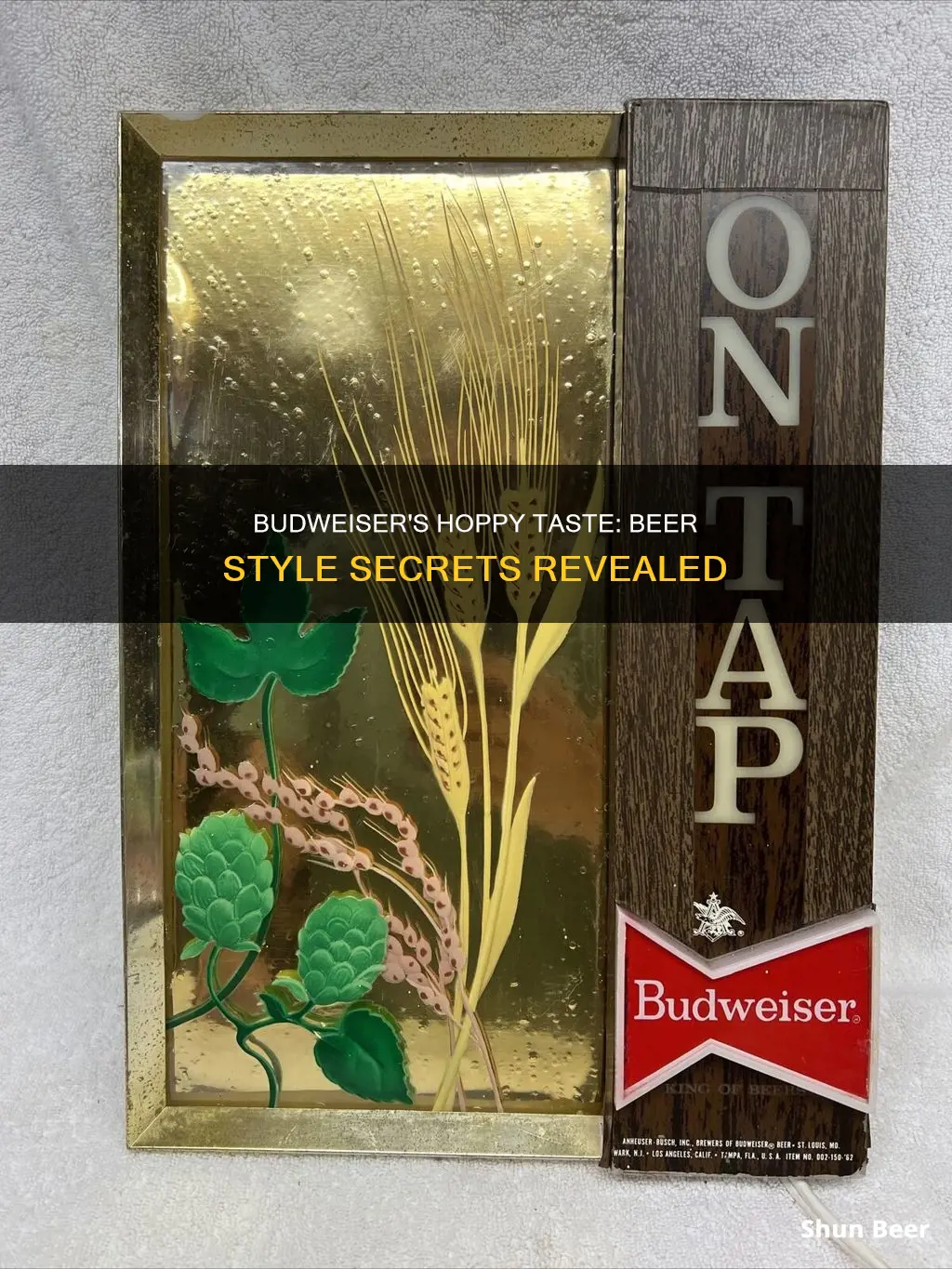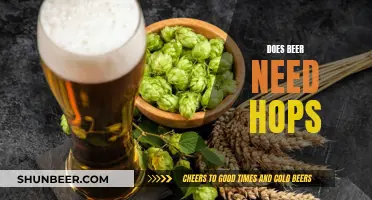
Budweiser is an American-style pale lager that was introduced in 1876 by Carl Conrad & Co. of St. Louis, Missouri. It is made with up to 30% rice in addition to hops and barley malt. In 2014, Anheuser-Busch revealed that Budweiser and Bud Light contain only five ingredients: water, barley malt, rice, yeast, and hops. Budweiser is produced using malted barley, rice, water, hops, and yeast, and the brewing process involves seven steps, including milling, mashing, straining, boiling in a brew kettle, primary fermentation, beechwood lagering, and finishing.
| Characteristics | Values |
|---|---|
| Type of beer | American-style pale lager |
| Brand | Budweiser |
| Company | Anheuser-Busch |
| Company headquarters | Belgium |
| Introduced in | 1876 |
| Introduced by | Carl Conrad & Co. of St. Louis, Missouri |
| Ingredients | Water, barley malt, rice, yeast, hops |
| Number of ingredients | 5 |
What You'll Learn

Budweiser's ingredients
Budweiser is an American-style pale lager that was introduced in 1876 by Carl Conrad & Co. of St. Louis, Missouri. Budweiser is a filtered beer, available on draft and in bottles and cans, made with up to 30% rice in addition to hops and barley malt.
In 2014, Anheuser-Busch, the company that produces Budweiser, revealed the ingredients in their Budweiser and Bud Light beers for the first time. This came after a popular food blogger, Vani Hari, started an online petition to get major brewers to list what’s in their beverages. The petition quickly gained over 44,000 signatures.
Budweiser is made with five ingredients: water, barley malt, rice, yeast, and hops. Water, which makes up over 90% of the beer, can have a significant impact on taste. Budweiser uses water with adjusted hardness to create either crisp, refreshing tastes or full, earthy tones. The natural minerals in the water can also "season" the beer by enhancing certain flavors.
Barley malt, which delivers a unique taste and aroma, contributes bready, toasted, and caramel-like notes to the beer. Hops, small, bitter, cone-shaped blossoms, add fruity, piney, and floral characteristics. Different types of hops are combined to balance the sweet notes and malty weight of the beer, creating a unique aroma and balanced bitter flavor.
Rice, which Adolphus Busch first added to Budweiser to set it apart from other lagers, lightens the body of the beer and gives it a subtle sweetness and crisp, clean finish. Budweiser is the largest end-user of rice in the United States and even mills some of its supply at its rice mill in Jonesboro, Arkansas.
Lastly, yeast is an important contributor to the flavor of beer. Budweiser uses different strains of yeast that turn sugars into alcohol, triggering unique smells and tastes. These strains add powerful aromas to the beer, such as banana, rose, apple, aniseed, almond, cloves, and even hints of pepper.
The brewing process for Budweiser involves seven steps: milling, mashing, straining, brew kettle, primary fermentation, beechwood lagering, and finishing.
Starting a Beer Hop Farm: A Beginner's Guide
You may want to see also

Budweiser's brewing process
Budweiser is an American-style pale lager, first introduced in 1876 by Carl Conrad & Co. of St. Louis, Missouri. It is a filtered beer, available on draft, in bottles, and cans, made with up to 30% rice in addition to hops and barley malt. Budweiser is brewed with a blend of imported and classic American aroma hops, and a blend of barley malts and rice. The brewing process involves seven steps:
Milling
The first step in the Budweiser brewing process is milling, where the malted barley is ground to prepare it for mashing.
Mashing
In the mashing stage, the ground malted barley is mixed with water to create a sugar solution known as wort. The wort will later be fermented to produce alcohol.
Straining
The mixture is then strained to separate the wort from the grain. This step ensures that only the desired sugars are carried forward in the brewing process.
Brew Kettle
The wort is then boiled in a brew kettle, where hops are added to provide bitterness, flavour, and aroma.
Primary Fermentation
During primary fermentation, yeast is added to the wort, which converts the sugars into alcohol. This process gives life to the beer and determines its flavour profile.
Beechwood Lagering
Budweiser is then lagered with beechwood chips in the aging vessel. This step helps to clarify the beer and smooth out its flavour.
Finishing
Finally, the beer undergoes finishing, which includes carbonation and packaging. Budweiser uses "kraeusening" for natural carbonation, resulting in a balanced and characterful beer.
Budweiser takes its brewing process seriously, ensuring that every batch is consistent and of the highest quality. The brewmasters at Anheuser-Busch are highly trained and skilled, with expertise in various fields related to brewing science. They carefully oversee every detail of the brewing process, from selecting quality ingredients to taste-testing each batch before packaging.
The Essential Ingredient in Beer: Hops or Not?
You may want to see also

Budweiser's history
Budweiser has a long and fascinating history that dates back to the 1800s. Here is a detailed account of the brand's journey over the years:
The Early Years
In the 1850s, Budweiser began as a small neighbourhood brewery called Anheuser-Busch in St. Louis, Missouri. The founder, Adolphus Busch, was a German immigrant who arrived in the United States in 1857. Busch married Lilly Anheuser, the daughter of local businessman Eberhard Anheuser, in 1861. After serving in the Union Army during the Civil War, Busch began working at his father-in-law's brewery, which was initially called Bavarian and later renamed E. Anheuser & Co.
Innovation and Expansion
Adolphus Busch, along with his friend Carl Conrad, played a pivotal role in the creation of Budweiser. In 1876, they developed an "American-style" or "Bohemian-style" lager, inspired by their travels to Bohemia (now part of the Czech Republic). This new lager became immensely popular and established Budweiser as a leading brand. The introduction of pasteurisation and artificial refrigeration by Anheuser-Busch allowed Budweiser to become the first nationally distributed beer brand in the United States.
Marketing and Growth
Adolphus Busch was not just a brewer but also a master of advertising and promotion. He utilised traditional selling methods but executed them with a more organised and deliberate approach than his competitors. Busch pioneered the use of giveaways and turned the Anheuser-Busch brewery into a tourist destination by offering public tours in the 1880s. The brand's iconic status was further solidified by its association with motorsports and sponsorships of major sporting events.
Challenges and Adaptations
During World War I and the subsequent Prohibition era, Budweiser, like many other breweries, faced significant challenges. However, they adapted by producing non-alcoholic beverages and later benefited from the association of beer with patriotism during World War II. The company also faced trademark disputes with the Czech company Budweiser Budvar Brewery over the use of the name "Budweiser," leading to varying brand names in different markets.
Global Presence
Over time, Budweiser expanded its global reach, particularly in China, where it is now the fourth leading beer brand. The company continues to innovate, whether through its diverse portfolio of products or its use of artificial intelligence in the brewing process. Budweiser remains one of the most recognisable and influential beer brands worldwide.
Hop Boiling in Beer: Necessary or Not?
You may want to see also

Budweiser's advertising
Budweiser has a long history of advertising, with a focus on TV commercials, sports sponsorships, and brand partnerships. The brand has been advertised since its introduction in 1876 and has become a large selling beer company in the United States.
One of Budweiser's most iconic advertising strategies is its use of Clydesdale horses, which were first introduced in 1933 as a symbol of quality, heritage, and tradition. These horses have become a staple of Budweiser's advertising campaigns, appearing in numerous Super Bowl commercials and delivering beer in ceremonial deliveries. The Clydesdales are often accompanied by a Dalmatian, a traditional guard of the beer wagon, and together they have become beloved figures in Budweiser's marketing.
In addition to the Clydesdales, Budweiser has also utilised other creative strategies in its advertising. For example, in 1969, they introduced the Superman-esque character, Bud Man, who inspired characters like Duffman from The Simpsons. Budweiser has also aired TV commercials with lizards, frogs, and the famous "Whassup?" campaign.
Sports sponsorships play a significant role in Budweiser's advertising strategy. The brand has sponsored various NASCAR teams and drivers, IndyCar drivers, and the BMW Williams Formula One team. Budweiser has also been the "Official Beer" of several sports leagues, including NASCAR, NHRA, and the British Basketball League. Additionally, they have sponsored major sporting events, such as the Daytona Speedweeks, Budweiser Shootout, and Budweiser Duel, further associating the brand with motorsports and athletic culture.
To reach a wider audience, Budweiser has also partnered with entertainment platforms like Major League Soccer, the Premier League, and the FA Cup. They have also advertised during the Super Bowl, one of the most-watched television events in the United States, ensuring their message reaches a massive audience.
In recent years, Budweiser has adapted its advertising strategies to modern platforms, such as partnering with the popular Chinese video-sharing site Tudou.com for a user-generated online video contest. They have also produced online reality TV series, like Bud House, which centred around the 2010 FIFA World Cup in South Africa. Budweiser continues to be a heavily advertised brand, with significant marketing budgets, ensuring its presence in the highly competitive beer market.
Hop Acids' Intricate Influence on Beer's Flavor and Aroma
You may want to see also

Budweiser's packaging
Budweiser has undergone several packaging changes since its introduction in 1876. The brand's packaging has played a significant role in its success and recognition as an American icon. In 2017, Budweiser unveiled a new state packaging inspired by its 12 local breweries across the United States. This limited-edition summer packaging celebrated the local states that Budweiser and its breweries call home. The packaging was specific to 11 states: California (with two Budweiser breweries), Colorado, Florida, Georgia, Missouri, New Hampshire, New Jersey, New York, Ohio, Texas, and Virginia.
The state-themed packaging included custom changes such as replacing "Budweiser" with each state name on cans and bottles, updating the centre medallion "AB" monogram with state initials, swapping "King of Beers" for each state's motto, and replacing "Anheuser-Busch Inc." with state nicknames. This initiative aimed to connect with local consumers and showcase Budweiser's presence in these communities.
In terms of design, Budweiser's packaging has evolved over time, reflecting the brand's rich history and immense iconography. The brand has collaborated with design agencies such as Jones Knowles Ritchie to develop a packaging system that emphasises its commitment to quality. The redesign drew inspiration from Budweiser's 140-year legacy, incorporating elements like the bowtie-shaped logo and timeless typefaces that blend modern and classic styles. The typography, illustration, and famous bowtie were all redrawn to reinforce the quality and craftsmanship associated with Budweiser.
Additionally, Budweiser introduced a custom sans serif font, "Bud Bold," inspired by the 19th-century industrial type on the original Budweiser bottle. This font is now used consistently across the brand's communications. The packaging changes have sparked interest in the brewery's history and led to a reappraisal of this iconic American brand.
Throughout its history, Budweiser's packaging has also been tailored to local customs and traditions. For example, in St. Mary's County, Maryland, 10 US fl oz (300 ml) cans are the preferred package. The brand's commitment to quality and its ability to adapt to local markets have contributed to its success and recognition worldwide.
Keeping Dry Hops Out of Beer: Techniques for Brewers
You may want to see also
Frequently asked questions
Budweiser is made with hops, but it is not considered a "hoppy" beer. It is an American-style pale lager with a mild, bready aroma and a crisp finish.
Budweiser is made with water, barley malt, rice, yeast, and hops.
Budweiser has a standard 5% alcohol by volume.
Budweiser is made by Anheuser-Busch, a division of the world's largest brewing company, Anheuser-Busch InBev.







